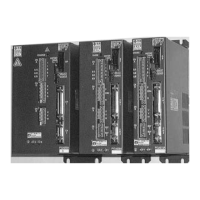2. FUNCTION, CHARACTERISTICS AND CONFIGURATION
2-3
● Servo tuning support function
When the remote operator sets a mode, the load inertia is automatically estimated and a proper
parameter is set. There are two different kind of tuning methods: one is “Offline auto tuning” executed
at test mode when offline, and the other is “Online auto tuning” estimating appropriate gain and
changing the gain at real time during operation.
● Electric gear function
For a position control type, the feed can be changed without changing the mechanical gear by using this
electronic gear.
This gear is set by the remote operator.
● Dividing output function
Encoder signal pulses can be output by being divided into N/8192 (N=1 to 8191), 1/N (N=1 to 64) or 2/N
(N=3 to 64) based on the setting by the remote operator.
Although the phase relation does not change, the 2/5 division is not the 90° phase difference.
To set the encoder signal dividing ratio, refer to the explanation on the parameters.
The dividing ratio must be a value with which the encoder pulse number can be divided.
For a 2000 pulses/rev encoder, for example, 1/3, 1/6 or 1/7 cannot be used since they are aliquant.
Some typical divided encoder output waveforms are described below.
● Alarm trace function
The past 7 alarm history data can be stored and reviewed from the remote operator or the front panel
SELECT, enabling easy troubleshooting.
OP
OP
OP
OP
Position command
f2
N
D
Input command pulse
When N = 1 to 32767 and
D = 1 to 32767
f2 = f1 ×
≦≦ 32767
f1
N
D
1
32767
N
D
90°
A-phase
Dividing ratio 1/1
B-phase
Dividing ratio 1/2
Dividing ratio 2/5
Typical encoder signal output waveforms (forward revolution)
A-phase
B-phase
A-phase
B-phase

